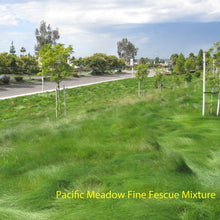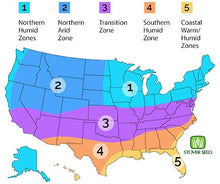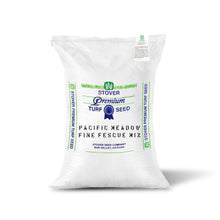PACIFIC MEADOW™ - Fine Fescue Mixture
An elite blend of three types of fine fescues (Hard, Chewings and Creeping Red) specifically designed for special landscape situations. It can be mowed or left unmowed to produce a very appealing ground cover or meadow. When left unmowed it will grow to a full mature height of 12 - 18 inches. It has a broad geographical adaptation from deserts through northern climates with excellent cold tolerance. Once established, it performs well in coastal climates under minimal irrigation schedules.
This mixture is a TWCA qualified product which means that the grass varieties in this mixture have successfully met a stringent set of documented criteria and have proven water conservation benefits.
| CHARACTERISTICS | |
|
Features |
Benefits |
USES
Pacific Meadow™ is a natural for use as a mowed turf or left unmowed for a natural, wispy ground cover with attractive seed heads.
• Ground Cover • Slopes • Medians • Golf Courses • Erosion Control • Roadsides
SEEDING RATES
5-7 pounds per 1,000 square feet or 200-300 pounds per acre. Rates are determined by the density of stand desired and whether the application is new or overseeded.
ESTABLISHMENT
Emergence: 3-5 days under optimum temperature range between 68-86 °F, longer under cooler temperatures. Under normal conditions establishment can be expected in 14-21 days.
| Specifications: PACIFIC MEADOW™ Fine Fescue Blend | |
|
55% Nanook Hard Fescue* |
98% Minimum purity |
|
* protected under the USA Plant Variety Protection Act |
|
CULTURAL INFORMATION
Water Requirements
Frequent, light watering is necessary for the seed to germinate and become established. Fine Fescues are cool season (C3) grasses. Once the grass becomes established it has the ability to withstand summer drought conditions under reduced irrigation schedules. For landscape professionals that use irrigation systems and calculations, fine fescues in this blend can be irrigated at up to 50% of average ETo (Reference Evapotranspiration) rates. Specific information on Turfgrass irrigation schedules and ETo rates can be found at:
http://ucanr.edu/sites/UrbanHort/
http://ag.arizona.edu/pubs/water/az1195.pdf
http://anrcatalog.ucdavis.edu/pdf/8395.pdf
General irrigation guidelines dictate that turf should be watered in early morning hours and that about 3/4 of an inch of water should be applied but not to the point of runoff.
Climate Conditions
Fine fescues are suitable to all climate conditions. Water usage is lowest in coastal climates and highest in desert regions. Once it becomes established it can withstand periods of increased heat and drought.
Soil Conditions
Fine fescues prefer well drained soil (clay or sandy) with a pH of 5.5 to 8.5.
Fertilization
Use of a starter fertilizer when seeding is highly recommended. After establishment, fertilize during periods of active growth in Spring and Fall with a balanced fertilizer such as Gro-Power 5-3-1 at 15 pounds per 1,000 square feet. Avoid using products with a high nitrogen (N) content as such use increases water usage. Apply no more than 4 pounds of N per 1,000 square feet per year.
Mowing
Fine Fescues can be mowed or left unmowed for a natural appearance with seed heads. If being mowed it can withstand heights as low as 1/2 inch. Never mow more than 1/3 of the leaf blade at one time.
TWCA
PACIFIC MEADOW™ is a “TWCA” qualified product that has been bred and tested to withstand longer periods of drought stress. The testing involves the establishment of the turf grass under optimal conditions allowing the full expression of above ground and below ground growth and then imposing a long term water deficit stress. During the development of drought stress, turf grass plots are monitored for their ability to maintain green cover under protracted drought stress, a process which Identifies those cultivars with either low water use or extensive root systems. Cultivars or selections that maintain green cover for longer periods can reduce overall water needs.
Drought tests are conducted by the Turf Grass Water Conservation Alliance (TWCA). This non-profit organization has established a science based method for qualifying cultivars for drought tolerance and other characteristics related to water conservation of grass seeds at low cost.
Studies are conducted in approved structures that restrict natural rainfall on the plot area during the drought stress period. The entries are replicated four times in a randomized complete block design. Planting rates for each species reflect industry standards. Following establishment, each species is maintained appropriately and fertilized according to standard practices.
Plots are maintained for a single growing season prior to initiating drought stress. Drought stress is replicated for two years in one location, or one year at multiple locations. The response of entries to drought stress is evaluated two times weekly using digital image analysis techniques to quantify the percent of green turf cover for each plot as drought becomes more severe.
When all plots fall below a 25% green turf cover, the experimental area is saturated to initiate drought recovery. Thereafter, the experimental area is irrigated weekly and recovery of entries from drought evaluated weekly using digital image analysis until plots reach 100% green cover.






